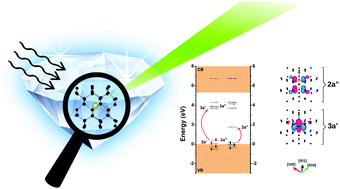Titanium-related color centers in diamond: a density functional theory prediction
Abstract
Transition metal-related paramagnetic centers in diamond exhibiting bright photoluminescence are increasingly important defects for realizing high quality solid state single photon sources. Recently, advanced ab initio calculations of single nickel-related NE4 (nickel-vacancy) and NE8 (nickel-vacancy-nitrogen) complexes in nanodiamond provided an insight into the nature of optical transitions and demonstrated their potential for in vivo biomarker applications. For other transition metal-related defects in diamond, however, a comprehensive understanding of photoluminescence is rather scarce. Here we used first principles, hybrid density functional theory analysis to investigate the electronic structure and magneto-optical properties of titanium-related point defects in diamond. Our theoretical results including the paramagnetic S = 1/2 ground state, the calculated zero-phonon lines, quasi-local vibrational modes associated with Ti atoms, and hyperfine coupling parameters provide strong evidence that the neutral Ti–N and TiV–N complexes are indeed the experimentally observed N3 (titanium–nitrogen) and OK1 (titanium-vacancy–nitrogen) color centers. In addition, we predicted another low energy excitation in the spin minority channel of the TiV–N0 defect that needs further experimental verification and might be an interesting candidate for a robust solid state single color emitter in the near IR region. In the case of a yet unobserved, neutral TiV (titanium-vacancy) defect we found a high symmetry D3d configuration in the triplet 3Eu ground state and we calculated the magneto-optical parameters to mediate its future identification. We emphasize the possibility of the dynamic Jahn–Teller effect for some centers and its impact on the experimentally observed hyperfine structure.



 Please wait while we load your content...
Please wait while we load your content...